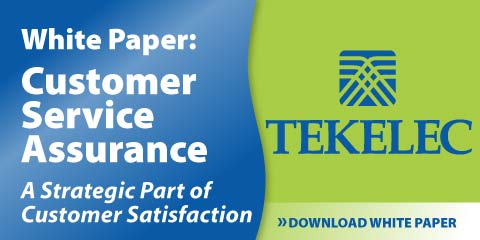
article page
| 1
| 2
|
customers want better billing. Service management guys? QoS. As H.M. Tomlinson wrote in The Gift, “We see things not as they are, but as we are ourselves.”
So let’s, instead, work backwards. Let’s see what CSPs are doing that’s effective.
One thing they’re doing is making promises they feel fairly sure that they can keep. That’s especially valuable for customers who are switching to a company with a different access technology. “Verizon’s flagship wireline service, FiOS, is in large demand, but changing to a new TV or Internet service can be unsettling,” said Bill Kula, a spokesman for Verizon. “With this Service Commitment, we’re making a promise to our new FiOS customers that their transition to more advanced home-entertainment and communication services will be smooth and easy, because we will stay with our customers every step of the way.”
|
|
“New customers get a direct phone number to reach the technician who installed their service, should they have any questions after the work is done.” |
|

by learning what their technology can really do is important. “Ongoing training sessions are available at select area Verizon Plus retail stores,” said Kula, “where customers can come in with equipment or system questions during store hours and get hands-on demonstrations and answers to their questions. “
In addition, helping customers help themselves is important. Kula points to Verizon’s success with a targeted, customizable web-based self-service tool available to customers. “The use of the online self-service site has produced more than 33 million visits year to date in 2009, an increase of more than 70 percent as
|
|
|
|

And promises can matter a great deal, provided they’re backed by actionable steps for ensuring that those promises are kept.
“The centerpiece of the Service Commitment is direct communication between the new FiOS customer and the Verizon team,” said Kula. “Under the commitment, the Verizon technician who installed the service will be available to ensure the customer’s service is working and to answer questions from day one.” This is where things get interesting and where we see the importance of direct customer interaction. “New customers get a direct phone number to reach the technician who installed their service, should they have any questions after the work is done.”
Consumers are skittish. They all know what voice-mail-Hell feels like, and, if they’re anything like me, they’d rather be serenaded by a dental drill than deal with, say, a telecom bill error just because they don’t want to wade through a million voicemail boxes to finally talk to someone who understands their problem and can actually do something about it.
Kula said that Verizon takes that one step farther, as well. “Verizon service employees will also check in by phone with new customers within the first 30 to 45 days of installation to answer any questions, review the customers’ first bill and ensure they know how to reach Verizon round-the-clock for any future needs.”
Kula also mentioned that helping customers understand how to optimize their experience
|
|

compared to the same time in 2008,” said Kula. More self-service means less headcount and better numbers, at least in theory.
However, it’s no secret that some customers just want to talk to someone with the expertise to help resolve a problem and the authority to directly fix it. For large, multi-play companies, that can mean specialization. “Verizon operates more than 15 Fiber Solutions Centers in the U.S. that are focused exclusively on helping customers with any FiOS-related questions they have, including upgrading speeds, adjusting their set-top box, asking questions about video on demand services and more,” said Kula. “Verizon also operates a large number of call centers that are dedicated to helping our DSL-based High Speed Internet customers and are staffed with customer service officials who are experts in the use of our copper-based High Speed Internet service.” That specialization is important, provided customers know who to contact in the event of any issues they may be experiencing with their service.
Just the beginning.
However, even CSPs who can’t afford tremendous call centers, and who needn’t be concerned about specialization because they only offer one product can gather new customers and explore new ways to keep them happy. Novelty fades, but even in the lean times, consumers retain communications services to stay in touch, stay informed, and stay entertained. You’ve just got to keep them happy.
|
|





